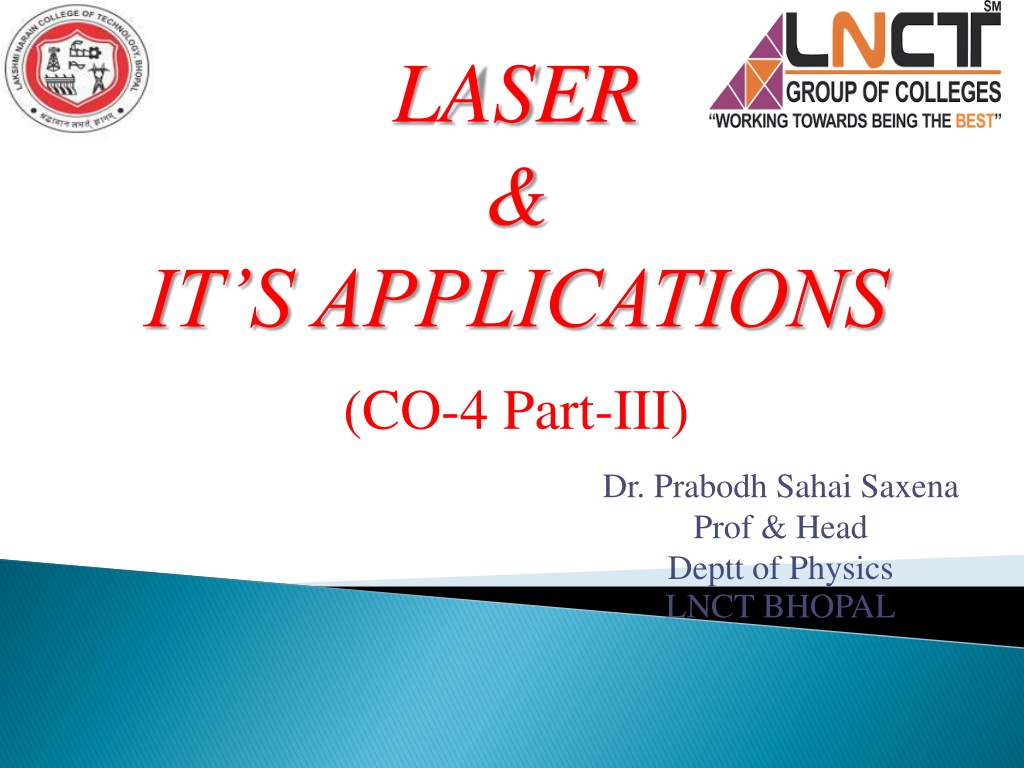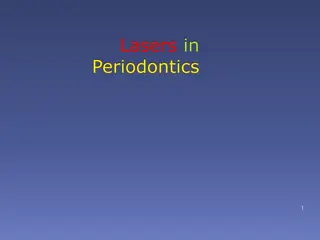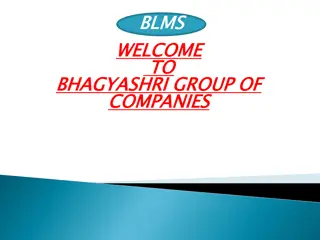Understanding Nd:YAG Laser and Its Applications
Nd:YAG laser is a solid-state laser system used in various applications due to its ability to generate laser light in the near-infrared region. This laser operates in a four-level system, with Nd:YAG crystal as the active medium. The construction, working principles, advantages, and applications of Nd:YAG and CO2 lasers are discussed in detail. By achieving population inversion through an energy source and optical resonator, Nd:YAG laser efficiently emits laser light at different wavelengths. Population inversion is crucial for the laser's functionality, leading to the emission of photons and efficient laser operation.
Download Presentation

Please find below an Image/Link to download the presentation.
The content on the website is provided AS IS for your information and personal use only. It may not be sold, licensed, or shared on other websites without obtaining consent from the author. Download presentation by click this link. If you encounter any issues during the download, it is possible that the publisher has removed the file from their server.
E N D
Presentation Transcript
LASER & IT S APPLICATIONS (CO-4 Part-III) Dr. Prabodh Sahai Saxena Prof & Head Deptt of Physics LNCT BHOPAL
Construction and working of Nd:YAG laser Advantages of Nd:YAG laser Applications of Nd:YAG laser Construction and working of CO2 laser Advantages of CO2 laser Disadvantages of CO2 laser Applications of CO2 laser
Nd: YAG laser is a four-level laser system, which means that the four energy levels are involved in laser action. These lasers operate in both pulsed and continuous mode. Nd: YAG laser is a solid state laser in which Nd: YAG crystal is used as a laser medium.Nd+3 ions are the active centers. Nd: YAG stands for Neodymium (Nd+3) doped Yttrium Aluminum Garnet (Y3Al5O12). Nd: YAG laser generates laser light commonly in the near IR region (infrared region) of the spectrum at 1064 nanometers (nm). It also emits laser light at several different wavelengths including 1440 nm, 1320 nm, 1120 nm, and 940 nm.
Nd:YAG laser consists of three important elements: an energy source, active medium, and optical resonator . The energy source or pump source supplies energy to the active medium to achieve population inversion. In Nd: YAG laser, light energy sources such as Krypton (Kr) arc lamp used as energy source. The active medium or laser medium of the Nd:YAG laser is made up of a synthetic crystalline material Yttrium Aluminum Garnet (YAG) doped with a chemical element neodymium (Nd). The Nd:YAG crystal is placed between two mirrors. One mirror is fully silvered whereas, another mirror is partially silvered.
The energy level E1is known as ground state, E2is the next higher energy state or excited state, E3is the metastable state or excited state and E4is the pump state or excited state. Let us assume that initially, the population will be N1> N2> N3> N4. When flashtube or laser diode supplies light energy to the active medium (Nd:YAG crystal), the lower energy state (E1) electrons in the neodymium ions gains enough energy and moves to the pump state or higher energy state E4. The lifetime of higher energy state E4is very small (10-8 sec). After this short period, the electrons will fall into the next lower energy state or metastable state E3by releasing non-radiation energy (releasing energy without emitting photons).
The lifetime of metastable state E3is high as compared to the lifetime of pump state E4. Therefore, the electrons reach E3much faster than they leave E3. This results in an increase in the no of electrons in the metastable E3and hence population inversion is achieved. After some period, the electrons in the metastable state E3will fall into the next lower energy state E2by releasing photons. The emission of photons in this manner is called spontaneous emission.
When photon emitted due to spontaneous emission is interacted with the other metastable state electron, it stimulates that electron and makes it fall into the lower energy state by releasing the photon. As a result, two photons are released. The emission of photons in this manner is called stimulated emission of radiation.
When these two photons again interacted with the metastable state electrons, four photons are released. Likewise, millions of photons are emitted. Thus, optical gain is achieved. In this way, several electrons on stimulation produce photons thereby generating a coherent laser beam of 10,640 .
Nd:YAG laser offers high gain. Low power consumption. The efficiency of Nd:YAG laser is very high as compared to the ruby laser. Nd:YAG laser has good thermal properties. Nd:YAG laser has good mechanical properties. It is much easy to achieve population inversion.
Nd:YAG lasers are used in laser designators and laser rangefinders. A laser designator is a laser light source, which is used to target objects for attacking. A laser rangefinder is a rangefinder, which uses a laser light to determine the distance to an object. Nd:YAG lasers are used for cutting and welding steel. It finds many medical applications such as endoscopy, urology, neurosurgery, ENT, gynecology, dermatology, dental surgery and general surgery. Nd:YAG lasers are used to remove skin cancers.
CO2 was the first molecular gas laser developed by Indian born American scientist Prof. C. K. N. Pillai. It is a four level gas laser and it operates at 10.6 m in the far IR region. It is a very efficient laser. Laser action is achieved by transitions between vibrational and rotational levels of molecules. Its construction is simple and the output of this laser is continuous. The active medium is a gas mixture of CO2, N2 and He.
A carbon dioxide molecule has a carbon atom at the center with two oxygen atoms attached, one at both sides. CO2 molecule exhibits three independent modes of vibrations. They are (a)Symmetric stretching mode:- In this mode of vibration, carbon atoms are at rest and both oxygen atoms vibrate simultaneously along the axis of the molecule departing or approaching the fixed carbon atoms.
(b)Bending mode:- In this mode of vibration, oxygen atoms and carbon atoms vibrate perpendicular to molecular axis. (c)Asymmetric stretching mode:- In this mode of vibration, oxygen atoms and carbon atoms vibrate asymmetrically, i.e., oxygen atoms move in one direction while carbon atoms in the other direction.
It consists of a quartz tube 5 m long and 2.5 cm in the diameter. This discharge tube is filled with gaseous mixture of CO2, helium and nitrogen with suitable partial pressures. The terminals of the discharge tubes are connected to a D.C power supply. The ends of the discharge tube are fitted with NaCl Brewster windows so that the laser light generated will be polarized. Two concave mirrors one fully reflecting and the other partially form an optical resonator.
Electrical discharge method is used for Pumping action. When an electric discharge occurs in the gas, the electrons collide with nitrogen molecules and they are raised to excited states. Now N2molecules in the excited state collide with CO2atoms in ground state and excite to higher electronic, vibrational and rotational levels. Since the excited level of nitrogen is very close to the E5level of CO2atom, population in E5level increases.
As soon as population inversion is reached, any of the spontaneously emitted photon will trigger laser action in the tube. There are two types of laser transition possible. Transition E5 to E4: This will produce a laser beam of wavelength 10.6 m. Transition E5 to E3 :This transition will produce a laser beam of wavelength 9.6 m. Normally 10.6 m transition is more intense than 9.6 m transition. The power output from this laser is 10kW.
It has high efficiency. The output of this laser is continuous. It has very high output power. The construction of CO2laser is simple. The output power can be increased by extending the length of the gas tube.
The operating temperature plays an important role in determining the output power of laser. The corrosion may occur at the reflecting plates. Accidental exposure may damage our eyes, since it is invisible (infra red region) to our eyes. The contamination of oxygen by carbon monoxide will have some effect on laser action.
High power CO2laser finds applications in material processing, welding, drilling, cutting soldering etc. The low atmospheric attenuation (10.6 m makes CO2laser suitable for open air communication. It is used for remote sensing It is used for treatment of liver and lung diseases. It is mostly used in neuro surgery and general surgery. It is used to perform microsurgery and bloodless operations.























